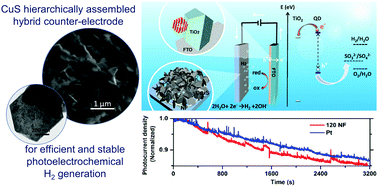Nanofiber-supported CuS nanoplatelets as high efficiency counter electrodes for quantum dot-based photoelectrochemical hydrogen production†
Abstract
We developed a hierarchically assembled hybrid counter electrode (CE) based on copper sulfide (CuS) nanoplatelets grown on polymer nanofibers. The resulting CE was used in a quantum dot (QD)-based photoelectrochemical (PEC) system for H2 generation in the presence of sacrificial agents (S2−/SO32−). The concept is to increase the specific surface area of the CE, aiming at maximizing charge exchange at the electrode, which boosts efficient generation of H2 and to obtain a stable structure for long-term operation of the device. Structural and morphological characterization indicated the presence of a covellite crystalline phase (CuS). PEC tests showed that the CuS nanoplatelets grown in the CEs could replace Pt CEs in either visible-active or near infrared (NIR)-active QD-based PEC systems. Specifically, saturation of the photocurrent density (∼7.5 mA cm−2) occurred at ∼0.6 V versus the RHE, when using a NIR QD-based TiO2 photoanode and a nanofiber-supported CuS as the CE. Stability tests of the nanofiber-supported CuS CE showed that 85% of the initial photocurrent density was maintained after ∼1 h, which is similar to that obtained with the Pt foil CE (86%). In contrast, CuS nanostructures directly deposited on FTO glass without nanofibers (CuS/FTO CE) exhibited poor stability. CuS/FTO CE degraded quickly, showing a 90% drop in the initial photocurrent within 200 s testing whereas a 14% drop in the initial photocurrent was observed for the CuxS on brass within 10 min of testing. Our new nanofiber supported-CuS CE stands out due to its higher performance compared to brass and its similar stability compared to Pt during long term PEC operation. Additionally, our hybrid CE showed a better catalytic performance than the Pt CE and good stability in cyclic voltammetry tests. These results demonstrate that the nanofiber-supported CuS is a promising cost effective alternative to Pt as a highly efficient CE for PEC H2 generation.



 Please wait while we load your content...
Please wait while we load your content...